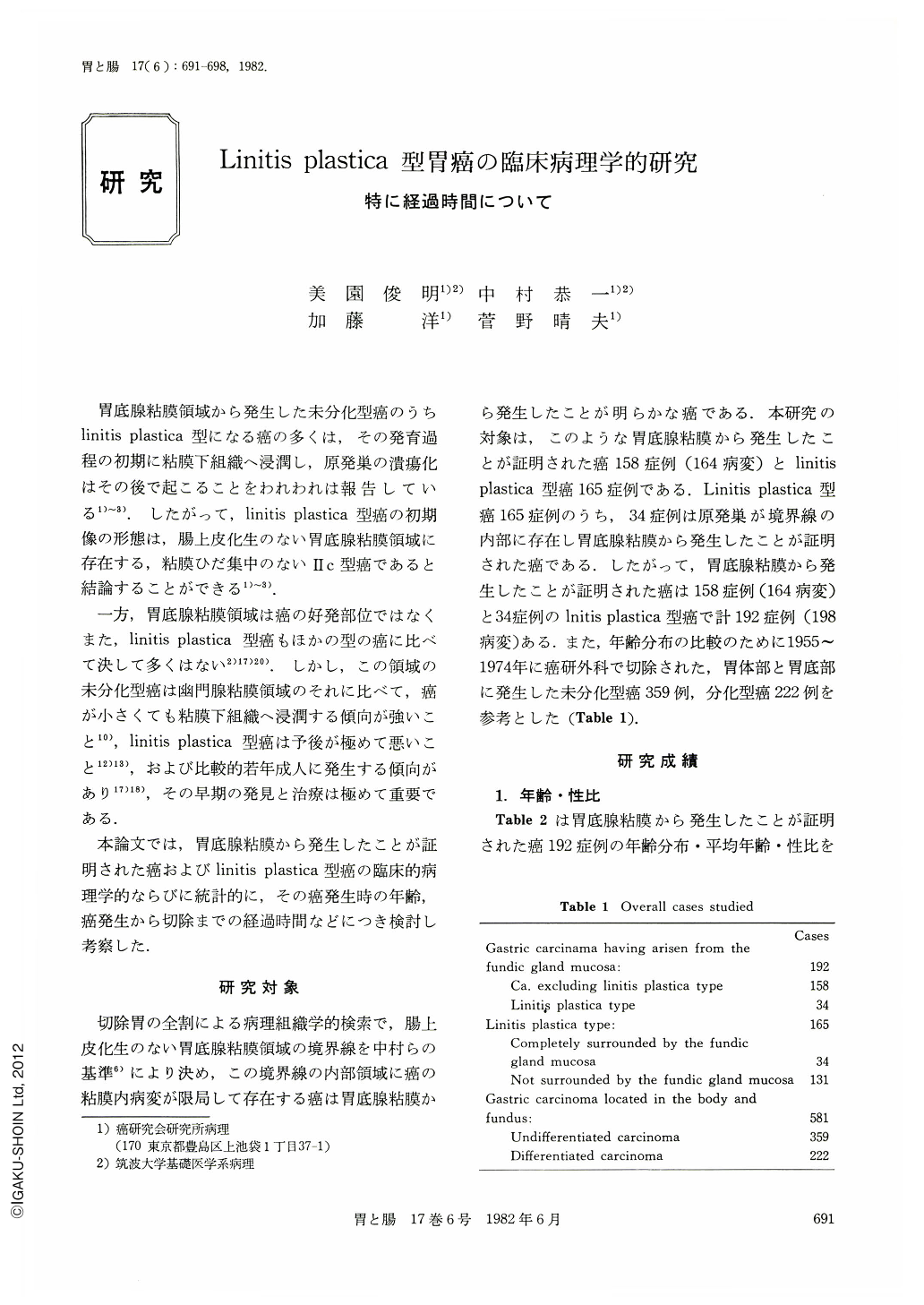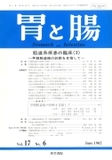Japanese
English
- 有料閲覧
- Abstract 文献概要
- 1ページ目 Look Inside
胃底腺粘膜領域から発生した未分化型癌のうちlinitis plastica型になる癌の多くは,その発育過程の初期に粘膜下組織へ浸潤し,原発巣の潰瘍化はその後で起こることをわれわれは報告している1)~3).したがって,linitis plastica型癌の初期像の形態は,腸上皮化生のない胃底腺粘膜領域に存在する,粘膜ひだ集中のないⅡc型癌であると結論することができる1)~3).
一方,胃底腺粘膜領域は癌の好発部位ではなくまた,linitis plastica型癌もほかの型の癌に比べて決して多くはない2)17)20).しかし,この領域の未分化型癌は幽門腺粘膜領域のそれに比べて,癌が小さくても粘膜下組織へ浸潤する傾向が強いこと10),linitis plastica型癌は予後が極めて悪いこと12)13),および比較的若年成人に発生する傾向があり17)18),その早期の発見と治療は極めて重要である.
The gastric carcinoma of linitis plastica type arises from the fundic gland mucosa and infiltrates the submucosa before the cancerous ulceration occurs in its primary focus. In this point of view, the Type Ⅱc without convergency of the mucosal folds is considered as the early stage of linitis plastica type. However, it is impossible to know the duration from the cancer development till the resection of the stomach.
The purpose of this study is the presumption of the average age of cancer development and that of the duration from the cancer development till the resection, concerning the gastric carcinoma arisen from the fundic gland mucosa and linitis plastica type.
Objects for this study were 164 cases of gastric carcinoma arisen from the fundic gland mucosa and 165 cases of linitis plastica type. The 34 cases out of 165 cases of linitis plastica type were demonstrated histologically to have arisen from the fundic gland mucosa (Table 1).
(1) The gastric carcinoma arisen from the fundic gland mucosa:
The gastric carcinomas arisen from the fundic gland mucosa occurred more frequently in younger female adults (Table 2). The majority of them were located in the anterior and posterior wall of the gastric body and the fundus neighboring the greater curvature (Table 5 a). All of these carcinomas but two cases were undifferentiated (diffuse) type (Table 6). These findings mentioned above were quite similar to those of linitis plastica type. In addition, the primary foci of 34 cases of linitis plastica type were completely surrounded by the fundic gland mucosa. Linitis plastica type, therefore, is concluded to have arisen from the fundic gland mucosa.
(2) Average age at cancer development:
As a cancer grows larger with the lapse of time, the size of the intramucosal cancer spread indicates the duration from its onset till the resection of the stomach. Moreover, the relation between the area of carcinoma in the mucosa (S cm2) and the lapse of time (t year) is S=0.3 t2.
Table 7 shows the average age at gastrectomy, the mean size of the intramucosal cancer extent and the mean lapse of time from cancer development. The mean lapse of time is caliculated from the values of actual measurement (the size of intramucosal cancer extent) and S=0.3 t2. The disparity between the average age at gastrectomy and the mean lapse of time from cancer development is the theoretically assumed average age at cancer development. It is 42~43 years old in all groups as shown in Table 7 and Fig. 2.
(3) The mean lapse of time from cancer development in linitis plastica type:
The majority of cases of linitis plastica type are considerably advanced carcinomas, so the area of intramucosal cancer extent is unknown. However, as the linitis plastica type of gastric carcinomas arises from the fundic gland mucosa, it may be interpreted that the average age at cancer development is 42~43 years old as mentioned above. On the other hand, the average age at gastrectomy is 50.7 years old (Table 7). The lapse of time from cancer development is considered to be about eight years according to these two figures.
The 34 cases of linitis plastica type, of which primary foci are completely surrounded by the fundic gland mucosa, are not so progressive that the accurate measurement of intramucosal cancer extent was taken. The mean lapse of time from cancer development was caliculated from these values of actual measurement and S=0.3 t2. It was about six years (Table 7).
Therefore, the average duration from cancer deveopment till the resection of the stomach in cases of linitis plastica type was interpreted to be six~eight years as shown in Fig. 3.

Copyright © 1982, Igaku-Shoin Ltd. All rights reserved.


